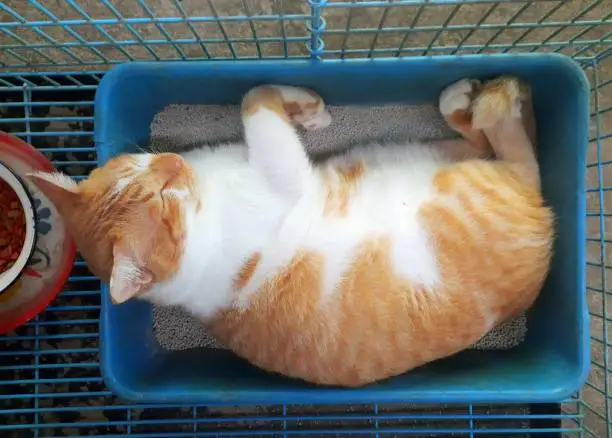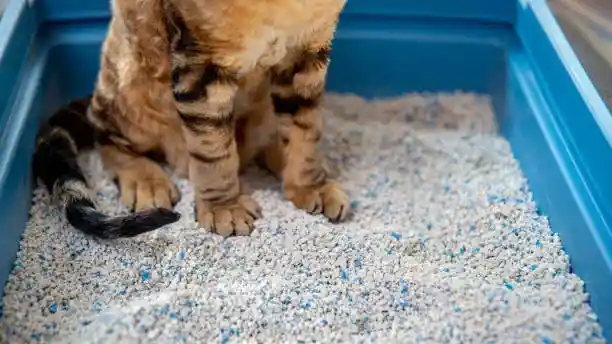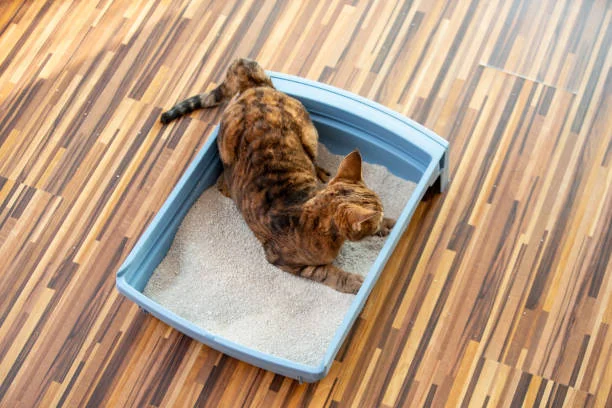Cats are known for their mysterious yet adorable behaviors, and one such behavior that leaves many cat owners both confused and intrigued is their love of rolling in the litter.
Many cat owners around the world have witnessed this phenomenon. They often share their experiences and express their confusion, trying to understand why their beloved pets behave this way. Why does my cat roll in the litter? Let’s explore together.
Why Does My Cat Roll in Litter?

Instinctive Drives
Territorial Consciousness:
Cats are territorial animals. In the wild, they mark their territory with urine, feces, and gland – secreted scents. At home, the litter box area is part of their territory. Rolling in the litter helps them exchange scents, marking it as their own, just like in the wild. This behavior gives them a sense of security.
Avoiding Predators:
Cats’ ancestors used the environment to hide their scent for survival. In a domestic setting, cat litter’s unique smell can be used as a cover. When cats feel threatened or uneasy, they roll in the litter to mask their own scent and avoid detection.
Comfort Factors
Cleaning Themselves:
Cats love cleanliness. Cat litter has absorbent and granular properties. When they have dirt or debris on their fur, they roll in the litter. The litter can absorb the dirt, and the rolling action helps groom their fur, making them feel more comfortable.
Temperature Regulation:
Cats are sensitive to temperature. Cat litter’s temperature varies from the environment. On hot days, the litter may be cooler, and cats roll in it to dissipate heat. On cold days, if the litter is warmer, they roll in it to get warm.
Health – related Issues
Skin Discomfort:
Skin problems like flea, mite infestations, or dermatitis can cause itching. The texture of the cat litter and the friction when rolling can relieve the itching. However, if cats frequently roll and show symptoms like scratching and hair loss, their skin health should be checked.
Discomfort in Facial Organs:
Cats’ ears and eyes are sensitive. If there are problems like ear mites, foreign objects in the ears, or dirt and inflammation in the eyes, they may use the litter to relieve the discomfort by rubbing. But this may worsen the problem, so owners should check and treat if needed.
Explore Common Myths and Misconceptions

Myth 1: Cats roll in the litter because they are dirty or lazy
One of the most common misconceptions is that when cats roll in the litter, they are simply doing so because they are dirty or too lazy to properly clean themselves. In fact, as we have discussed before, this behavior is often done for instinctual, comfort, or health reasons. Cats are naturally clean and spend a lot of time grooming themselves.
The behavior of rolling in the litter often has more complex meanings than just a lack of hygiene. Rather than being dirty or lazy, it may be an effort to control body temperature, mark territory, or address an underlying health issue.
Myth 2: It’s always a sign of a serious health problem
While it is true that health issues can cause cats to roll in the litter more frequently, it is a mistake to assume that every occurrence of this behavior is a red flag for a major health problem. Sometimes, cats may engage in this activity out of normal territorial instincts or a simple need for comfort.
For example, if a cat has just been introduced to a new environment or new objects in the home, it may roll in the litter as a way to feel more secure by marking its territory. Noticing this behavior should prompt observation, but not immediate alarm. Before jumping to conclusions about their health, it’s important to look for other accompanying symptoms, such as excessive scratching, changes in appetite, or lethargy.
Myth 3: Changing litter types will stop this behavior
Some cat owners believe that if they change litter types, their cats will stop rolling in the litter. However, the reasons for cat rolling behavior are deeply rooted in their instincts and physical sensations. For example, if a cat rolls in the litter to relieve itchy skin caused by fleas, changing litter types will not solve the underlying problem.
Similarly, if it is a territorial or comfort-based behavior, the cat may continue to exhibit this behavior regardless of litter type. Of course, in some cases, if the current litter texture or smell is unpleasant and causes discomfort to the cat, changing litter may have an impact, but it is not a universal solution.
Myth 4: Punishing a cat will correct this behavior
Punishing a cat for rolling in the litter is not only ineffective, but it can also damage the cat’s relationship with its owner. Cats do not understand punishment the same way humans do. When punished, they may become confused, stressed, and even more likely to behave this way out of anxiety.
Understanding the root cause of the behavior and addressing it with appropriate environmental adjustments, health checks, or providing other comfort options is key to managing this behavior, rather than punishment. For example, if a cat rolls in the litter box because it’s too hot, providing a cool, comfortable place to rest may be a better option than scolding the cat.
Expert Insights and Tips

Insights
Veterinarians and behaviorists emphasize understanding the feline mindset and evolutionary history. Their territorial awareness and survival instincts determine cats’ rolling behavior.
Tips
Observation: Observe your cat’s rolling behavior regularly. Pay attention to the frequency and related environmental changes.
Cat litter box: Clean it daily and change it regularly to keep it clean. Place it in a quiet, safe place away from noise and drafts.
Health: Get regular veterinary checkups. If your cat shows unusual symptoms when rolling, such as scratching or changes in appetite, see a veterinarian as soon as possible.
Environment: Provide toys and activities to stimulate your cat. Create a comfortable space with a bed or hiding spot to reduce stress and abnormal behavior.
How to Stop Cat Rolling in Litter?

If you want to stop your cat from rolling in the litter, first, check if your cat has any health problems, as a sudden increase in rolling may be caused by skin problems or other discomfort, and you need to take your cat to the veterinarian. Secondly, it is crucial to keep the litter box clean; clean the litter box every day and change the litter regularly, as a dirty litter box makes cats feel uncomfortable.
Regularly combing your cat’s hair can help keep the cat’s hair clean and reduce the cat’s urge to use the litter. Make sure the environment around the litter box is comfortable, quiet, free of drafts and extreme temperatures, and provide a comfortable resting place. In addition, when cats use the litter box correctly, they can be trained and positively reinforced by rewarding them with treats or praise.
Should I Stop My Cat From Rolling in the Litter?

Some partners may be more concerned about Should I Stop My Cat From Rolling in the Litter? If it happens occasionally and does not cause health problems, it may be a normal behavior related to instinct or comfort.
But if it is excessive, causes skin problems, or is accompanied by other abnormal symptoms, you may need to solve the problem by checking health, improving the condition of the litter box, and providing a comfortable environment.
Conclusion
In summary, understanding your cat’s behavior requires watching for signs of distress or health issues. If it’s just normal instinct or seeking comfort, you probably don’t need to intervene. But if there are worrisome symptoms, consult your veterinarian.









